by Tedd A. Long
Each December, members of Toledo’s Old Newsboys Goodfellow Association are seen throughout Northwest Ohio as they conduct their annual charity paper sale. Many people recognize their familiar canvas newspaper bags and homemade donation buckets, but few actually know the story behind the origins of one of Toledo’s 100% charities.
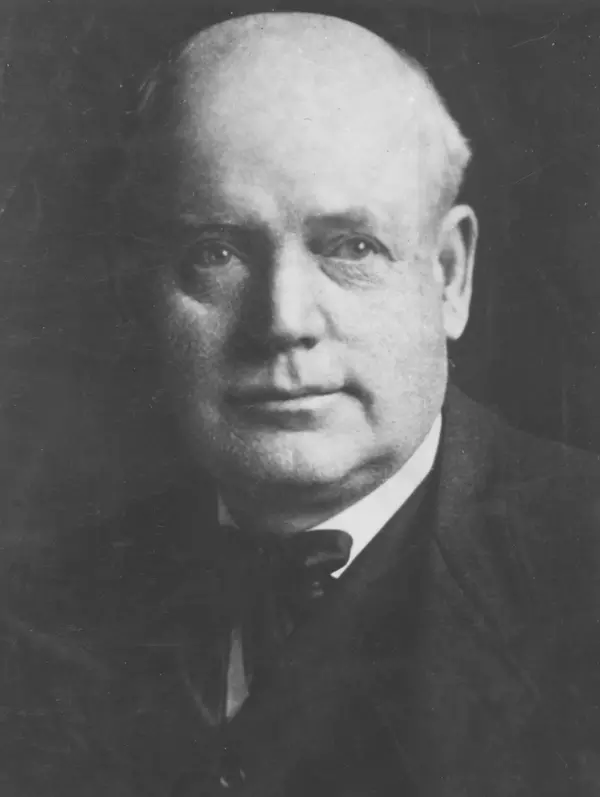 John Gunkel, founder and life president of the Toledo Newsboys Association
John Gunkel, founder and life president of the Toledo Newsboys Association
The Old Newsboys evolved from an idea of a few men who were once members of a newsboys association as kids into one of the region's most recognizable charities. Today, members carry on a tradition that is over 75 years old. Although Toledo’s Old Newsboys were officially organized in 1929, the story behind this unique charity institution began in the 1890s.
On December 25, 1892, John E. Gunckel, a passenger agent with the Lake Shore & Michigan Southern Railroad, invited roughly 100 newsboys to a Christmas dinner at the Marine Building on the corner of Water Street and Madison Avenue in downtown Toledo. During the dinner, Gunckel proposed that an association be formed where the often maligned newsboys would govern themselves and learn a sense of competence, usefulness, belonging and influence. This was the beginning of the Toledo Newsboys Association.
The newsboys asked Gunckel or “Gunk,” as they nicknamed him, to direct their association, and leading citizens of the time were elected trustees. Rules were established for the boys, including: no swearing, stealing, shooting craps, drinking, or smoking cigarettes. Self-rule was the mainstay of the organization. Membership was free to any boy between 9 and 17. There were no initiation fees and no dues or assessments. A membership card and a badge that the boys wore proudly on their lapels indicated their connection to the association. The badge was shaped like a lucky acorn that Gunckel kept in his pocket.
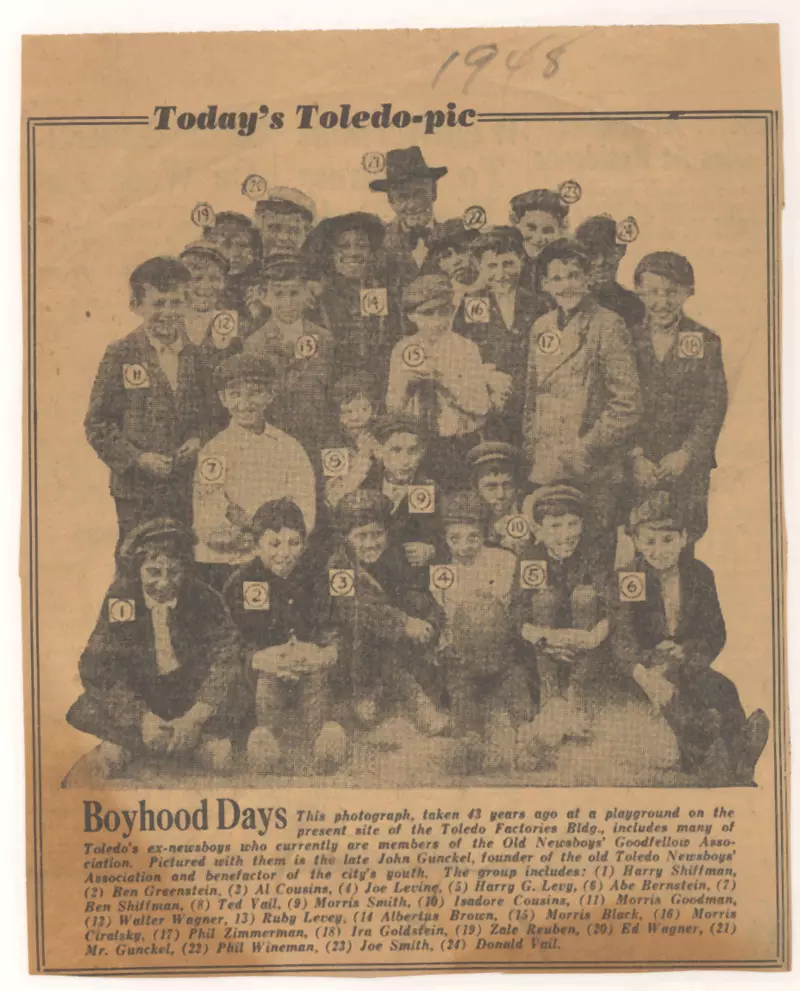 Boyhood Days, 1948 newsclipping
Boyhood Days, 1948 newsclipping
John Elstner Gunckel was born on August 14, 1846 in Germantown, Ohio, where his family was known as pioneers of the area. After graduating from high school, he left Germantown to attend Oberlin College. He left college due to financial constraints in his junior year and began his business career in real estate, which brought him to Toledo in 1875. Eventually, Gunckel used the people skills he learned in the real estate business to become a ticket agent, then passenger agent, for the Lakeshore and Michigan Southern Railroad.
As a representative of an important local railroad, Gunckel was well acquainted with Toledo’s business community. He was invited to major social functions and afforded various opportunities to meet with the elite business leaders of the city. In contrast, as a passenger agent with an office in a very busy part of the city center, Gunckel also interacted with Toledo’s underclass. It was during his career as a passenger agent that Gunckel began his efforts to help newsboys, bootblacks, and other boys from the street by opening his office in Toledo’s Boody House hotel so the boys could warm their feet and talk with him about how to better their lives.
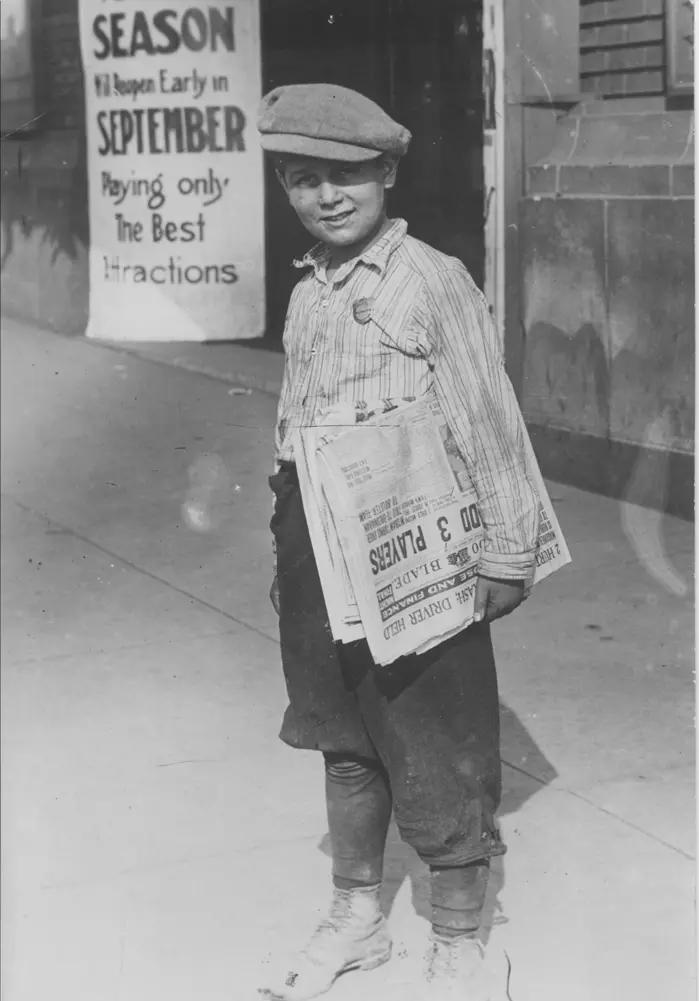 A newsboy selling the Toledo Blade
A newsboy selling the Toledo Blade
To understand the plight of the newsboy in the 1890s, it is important to remember that, at the end of the 19th century, immigration into the United States was at an all-time high and poverty was rampant. When many of the immigrants arrived, both adults and children searched for jobs and living quarters. Around this time, the American newspaper industry began to boom, thanks to the development of the steam press, and newspapers required cheap workers to distribute their daily penny paper editions. This was the “golden age” of the American press that helped establish many of the country’s great newspapers. The 1890s were also a period when Toledo’s industrialists–such as glass manufacturers Edward Ford and Edward Drummond Libbey–were arriving from the East, and the city was growing at a very rapid pace. From 1865 to 1895, Toledo’s population swelled from just under 25,000 people to over 130,000. The city was hungry for news and in need of newsboys to distribute the papers. In fact, at the time Gunckel helped organize the local newsboys association, three newspapers were using children as young as eight years old to sell papers on the streets of Toledo.
The life of a newsboy in Toledo, as in other cities, was tough. In many cases, these boys (and some girls) needed to sell papers in order to buy food and survive. Most were not regularly employed by a newspaper; they were, in a sense, entrepreneurial street merchants. They bought the morning and evening edition newspapers at wholesale prices and retailed them to people on the streets and in restaurants, taverns, and streetcars in bitter cold and stifling heat. Because many of them had to sell papers from early morning until late evening in order to earn enough to eat, most newsboys did not attend school. Many of them were orphans, living on the street. Some did have families and homes, but the lure of hanging out on busy streets with friends—and the excitement that often accompanied the newsboy profession drew boys to the work. Many newsboys abandoned their broken situations at home and adopted their fellow newsboys as their new family.
Gunckel’s decision to lead the effort to bring about a Newsboys Association in Toledo during that fateful Christmas dinner in 1892 would forever change his life, and the lives of those he set out to help. For the next 22 years, Gunckel devoted most of his time to his “newsies.” Eventually, he resigned from the Lake Shore Road, but President W.R. Callaway offered to retain him on the payroll of the New York Central Line with the privilege of devoting all of this time to his work among the newsboys. With the advice of his trustees, the generous offer was declined. He also turned down offers to run for mayor of Toledo because he was so devoted to his work. After resigning from the railroad, he wrote a book about his experiences. He called his book Boyville and it was filled with his philosophy about recovering, training, and developing kids from the streets into useful citizens. The popularity of the book led to requests for lectures by Gunckel from groups across the country. Proceeds from the book and lectures were given to the Newsboys Association.
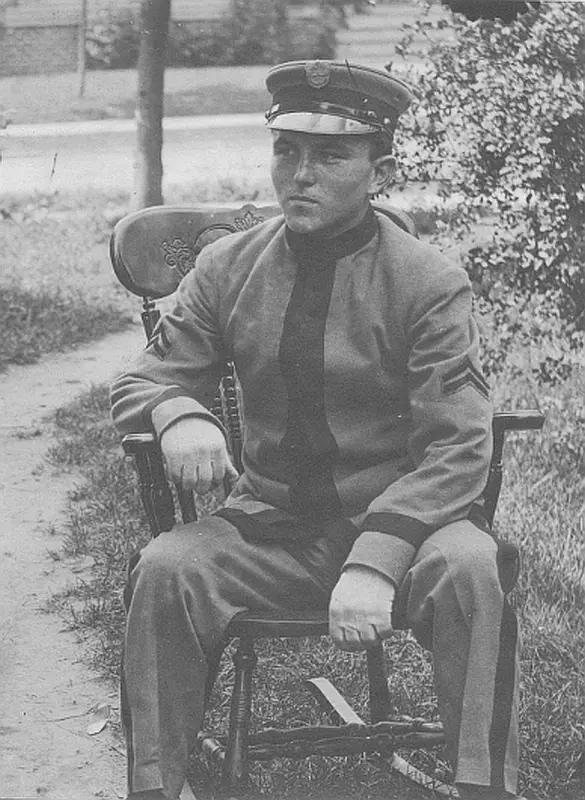 A member of the Newsboys Association Cadets poses in his uniform.
A member of the Newsboys Association Cadets poses in his uniform.
The Newsboys Association flourished under Gunckel’s leadership. A marching band was formed and an associate group called the Cadets was organized. Thanks to the success of his new book and his participation on the lecture circuit, Gunckel’s concept for helping street kids recognize their value to society was expanded to the entire country. Similar newsboys associations were organized in many large cities in the United States. In 1904, with the endorsement of the National Association of Managers of Newspaper Circulation, the National Newsboys Association was organized in St. Louis during the World’s Fair and Gunckel was chosen as President.
In 1905, the trustees of the Newsboys Association sent Toledo’s Newsboys Association Band and Cadets—65 boys in all—to the inaugural parade of Theodore Roosevelt. Gunckel later proudly wrote that the President was “immensely pleased with the newsboys and could not say enough about the remarkable appearance they made."
Gunckel was becoming very popular throughout the country. A 1907 letter sent to the Toledo Blade from A. E. Winship, editor of the Journal of Education in Boston, mentioned that Gunckel’s five-day visit there encompassed “nine remarkable addresses” that resulted in Boston being “thoroughly Gunckelized.” His speeches often focused on the “acres of diamonds” theme first delivered by Baptist Minister and founder of Temple University, Russell H. Conwell. “At your doors,” Gunckel told the audiences he spoke to during his travels, “are acres of diamonds only waiting for you to help in the work of polishing.”
By 1908, Gunckel worked with his trustees and area business leaders to raise funds for the construction of a building on Toledo’s Superior Street to house the Newsboys Association. Ground was broken on April 11, 1908. The Newsboys Association building was the culmination of Gunckel’s vision. It included a 1,200-seat auditorium, a 350-seat lecture hall, a swimming pool, billiard room, gymnasium, library, offices, and a large kitchen. The Newsboys Association building allowed the organization to host programs of cultural enrichment and entertainment, including Sunday afternoon lectures and music. This postcard celebrates the Newsboys Association Band, famous for their appearance at Theodore Roosevelt’s 1905 inaugural parade in Washington, D.C.
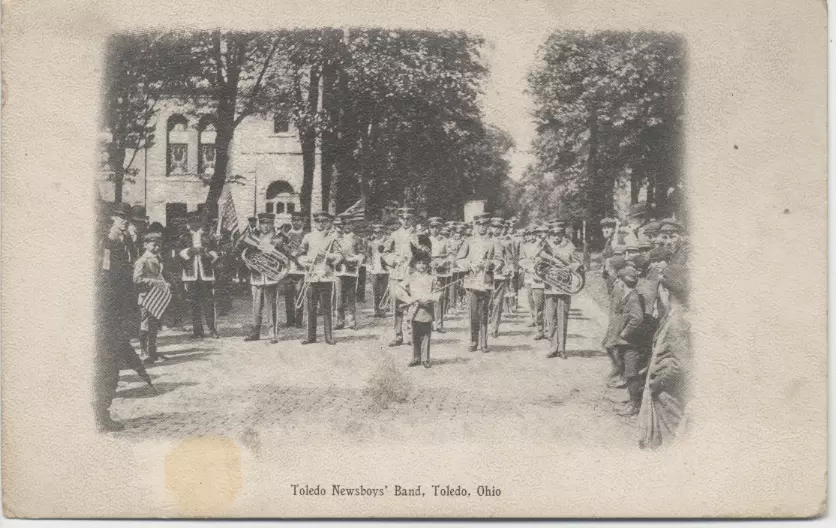 Postcard: Toledo Newsboys' Band, Toledo, Ohio
Postcard: Toledo Newsboys' Band, Toledo, Ohio
Over time, Gunckel’s efforts led to the rescue of many boys. It introduced them to a life of decency and self-respect. Under his guidance, hundreds of them were led to the heights of success in business, politics, and the arts. In fact, two early Hollywood stars with Toledo roots, Danny Thomas and Joe E. Brown, took great pride in the fact that they were once one of “Gunck’s boys.” Many major civic leaders also grew out of Gunckel’s programs.
Perhaps a story from a popular 1950s Toledo Blade series called “The Men Who Made Toledo” captured the essence of Gunckel best. As the story goes, some Toledo industrialists were meeting when a newcomer to the group asked, “Who was this John Gunckel and where did he make his money?” The reply was simple and matter of fact: “John Gunckel didn’t make money—he made men.”
The success of John Gunckel’s relationship with Toledo’s newsboys entreats two important questions. First, what motivated Gunckel to step into the role of mentor to what many of the day considered to be street urchins? Second, why did these street boys take to this middle-aged passenger agent so well?
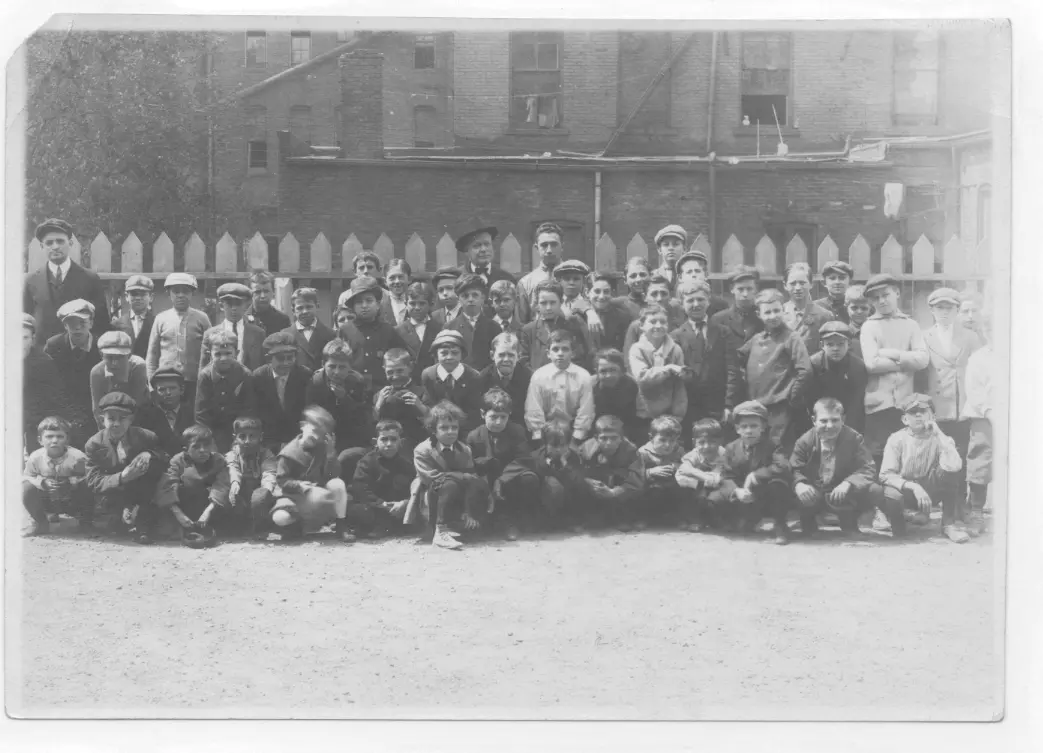 John Gunckel poses with staff members and boys from the Newsboys Association.
John Gunckel poses with staff members and boys from the Newsboys Association.
Some have questioned whether Gunckel was motivated by outside interests to organize Toledo’s newsboys before they organized themselves, as was the case in other large metropolitan areas. In New York, for example, the newsboy strike of 1899 against the Hearst and Pulitzer newspapers lasted two weeks, causing Pulitzer’s World to reduce its circulation from 360,000 to 125,000. Was Gunckel paid by area newspapers to organize the Toledo newsboys before they banded together–as they did in New York–to demand a better deal on newspaper distribution? While it is true that area newspapers supported Gunckel’s efforts financially through the sponsorships of the Newsboys Association activities and in ink by means of positive coverage of his efforts, there is no direct evidence that Gunckel was motivated to lead the Toledo newsboys to satisfy any commercial interests.
Another key question in the Gunckel story is why late 19th century society allowed the exploitation of newsboys to grow to such an extent that a railroad passenger agent needed to leave his career to help organize the Toledo boys. In fact, studies were made by many reform organizations to point out the abuses of child labor and, in particular, the rough conditions for newsboys. Helen C. Dwight, reporting on the situation in Detroit for the National Child Labor Committee, said that “the evil [of street trading] cannot be mitigated; it must be stopped,” a contention endorsed in reports from Dallas; Birmingham; and Springfield, Massachusetts. In 1899 at Chicago’s Hull House, J. J. Kelso of Toronto said, “The first step in the work of the juvenile court is to compel the newsboys to keep off the streets and abolish this system. People should be trained to buy their papers in stores.”
Nevertheless, resistance to the reform of how newsboys were used to distribute newspapers was strong. Wilma I. Ball’s study of street trading in Cleveland and Cincinnati documented a comment from a judge in the Court of Domestic Relations of a small Ohio town who found it inconceivable that the government should enact laws “to deprive [the newsboy] of. . .mental, physical, and financial opportunity because a small percentage of urchins engaged in selling papers are found stealing, gambling, and begging.”
Was Gunckel supported by area business leaders to help preserve a practice that was under scrutiny from the reform movement? It’s not an easy question to answer. Perhaps Gunckel was simply following the lead of others. He was not the first person to reach out to help the newsboys. The first organized effort to help them was made in 1853, when Charles Loring Brace, a Protestant Minister from New York, started a newsboys’ lodging home that later became the Children’s Aid Society. In the 1870s, Father Christopher C. Drumgoole of New York was credited as the unofficial patron saint of the homeless newsboys of New York City. In 1881, Drumgoole established the Saint Vincent Newsboys’ Home and in 1882, he built the Mission of the Immaculate Virgin, located in New York’s Printer’s Row district. Drumgoole later introduced a vocational school and a working farm on Staten Island. In Brooklyn, a Newsboy’s College was proposed in 1894, where “street urchins” would be provided a comfortable home and a fair education. Gunckel had many examples to follow when he helped organize Toledo’s newsboys. However, most of the programs introduced before Gunckel revolved around a “newsboy home” and a plan in which the boys were required to forfeit a portion of their earnings to pay for expenses. In some cases, all money was given back to the home and a “savings account” was established to help the boys move on with their lives after they finished their newsboy career.
Gunckel’s plan was different. There was no fee for the newsboys to participate; he depended on funds donated by area businessmen—many of whom he met while serving with the railroad—to sustain his Newsboys Association programs. While it can be argued that the chief benefits of their financial participation was the avoidance of a newsboys union and the continuation of a child labor system that benefited the newspapers and their advertisers, there were honorable benefits to Gunckel’s sponsors, including a reduction in street crime and a better reputation for the city of Toledo. Gunckel once wrote that “it need not be told that our newsboys, as a general rule, as people know them, are regarded as a swearing, stealing, lying, dishonest lot of young criminals, and these qualifications are recognized adjuncts to their business.” But Gunckel’s Newsboys Association certainly changed that image in Toledo. A 1905 article in New Era magazine entitled “A Toledo Philanthropy” portrayed the benefits of Gunckel’s efforts as a “general moral uplift.” The article described how a stranger to Toledo “sees a difference in the sellers of papers and shiners of shoes from those of the same class in most other cities.” Gunckel supporters may have viewed their financial encouragement as a means of cleaning up their city. Whatever the reason, businesses supported Gunckel’s programs in three classes: the Special Sustaining Members gave $50 annually; the Sustaining Members gave $25 annually, and the Contributing Members donated $5 or more annually.
We may never know what ultimately inspired John Gunckel. Perhaps he related to the financial plight of the newsboy because of his own experience of having to abandon his college career due to a lack of funds—an experience that stayed with him the rest of his life. In a 1907 letter he penned to Oberlin College, he attached a newspaper article that mentioned his success as a national lecturer and pointed out that he was “a student in Oberlin several years” but did not graduate because “I didn’t have the means.” In the conclusion of the letter, Gunckel implores the reader not to forget him or “there’ll be some thing doing.”
In Boyville, Gunckel described the prospect of helping the newsboys as an opportunity that comes once in a lifetime. He wrote, “To get in touch with that life, to draw out the goodness of heart and make it a tangible blessing to the boys of our land, is the work every man and woman ought to try to do.” He also touched on a religious motivation when he wrote, “If Christian people do not find time, amid the rush and roar of the city, in their mighty struggle for wealth, to lend a hand to lead him out on the highway of honest success, what is to become of the street-boy?”
What motivated the newsboys to accept Gunckel’s offer to organize them is another important question. Toledo’s newsboys had trusted others who had extended offers to help before and the story did not end as brightly as it did with Gunckel. A 1946 Toledo Times article celebrating the 100th anniversary of Gunckel’s birthday described how “an aged woman, gray-haired with kindly face” started a newsboys home in the 1890s at Erie Street and Madison Avenue. The woman offered homeless bootblacks and newsboys a night’s lodging for a small fee, and she also offered to establish a savings account to help them protect their life savings. Sadly, in 1892, the savings account had grown into a sizeable fund and the woman with the “kindly face” disappeared with the money. Some say this incident was a major motivation for Gunckel to organize the newsboys and declare self-rule.
Another outcome of the “gray-haired lady” embezzlement incident was the formation of a bootblacks union. The Toledo bootblacks formed a union in 1892 and refused to let the newsboys belong. Street battles between the two groups were frequent. Although Gunckel had been allowing newsboys to use his Boody House office as an informal meeting place to discuss their issues for several years, his formation of the Newsboys Association in 1892 was more than likely precipitated by these events. Over the next ten years, Gunckel invited the bootblacks to join the Newsboys Association, pointing out there were “no nice old ladies” to rob them. Still, the question remains: why did the boys work with Gunckel? It may be that the boys believed in Gunckel because he showed them a level of respect they had never seen before from an adult.
In “An Appreciation” written for the Toledo Times just days after Gunckel’s death, Grace Margaret Wilson wrote: “He was a friend of the friendless, a champion of the despised and outcast. He saved the boys by believing in them and appealing to their honor. He won their love by a kindliness that never patronized, was able to help them by meeting them on equal terms, and inspired them by taking the stand that ‘there are no bad boys.’”
William E. Paris, a Gunckel disciple as a newsboy who later became the Vice President in charge of Production at Willys-Overland Motors, recalled in a 1946 interview why he trusted Gunckel: “Every kid was a man to him. He treated us as if we were adults, and he had that personality about him that made us feel as if we counted for something.”
John E. Gunckel passed away on August 16, 1915, eleven years to the day after the National Newsboys Association was founded at the World’s Fair. Memorial services were held at the Newsboys Association building and more than 1,600 people came to pay final respects to the group’s founder. As tribute to their fallen leader, the newsboys organized the construction of a memorial for Gunckel in Toledo’s Woodlawn cemetery. Dedicated on August 11, 1917, the memorial is a pyramid-shaped monument composed of over 30,000 stones contributed by newsboys and Toledo-area school children. Some of the stones were sent from distant places such as the Holy Land, China, and Japan. Each year on August 16th, the people of Toledo celebrate the life of John Gunckel by placing flowers at his grave.
J.D. Robinson, president of Libbey Glass Company, succeeded Gunckel as president of the Newsboys Association. Robinson expanded the services of the organization to include vocational and recreational programs. Robinson worked with his good friend, C. O. Miniger of Toledo’s Electric Auto-Lite, to add facilities to the Newsboys Building so that classes in carpentry; drawing; shoe repair; typing; printing; and journalism could be offered. Career guidance counseling was also available.
After Robinson's death in 1929, the organization went through a period of rapid change. For a year, Gunckel’s son, Will Gunckel, headed the organization; he was followed by Joseph Robinson, J.D. Robinson’s son. Joseph Robinson expanded the board of trustees and founded Camp Big Silver on the Robinson Memorial Reservation in Pinckney, Michigan in 1936.
In 1942, John Gunckel’s Toledo Newsboys Association officially became the Boys Club of Toledo. The club expanded to include girls in 1982 and was renamed the Boys and Girls Clubs of Toledo. Today the clubs serve over 6,000 members as an organization dedicated to promoting leadership, character, health, and career development while emphasizing social, cultural, and educational growth. With a special concern for youth from disadvantaged backgrounds, professional staff and volunteers use daily and varied programs in neighborhood facilities to help youth develop the self-esteem and self-reliance to become responsible and caring citizens.
In late 1929, a group of Toledo-area men, all badge-carrying members of Gunckel’s Newsboys Association as kids, met at the Newsboys Association building on Superior Street to discuss current events. When the topic turned to the economy and the worsening of conditions for Toledo’s poor children, the men determined it was time to act. They decided to organize as the Old Newsboys Goodfellow Association. Their mission was to provide relief to children by supplying much-needed coats and shoes.
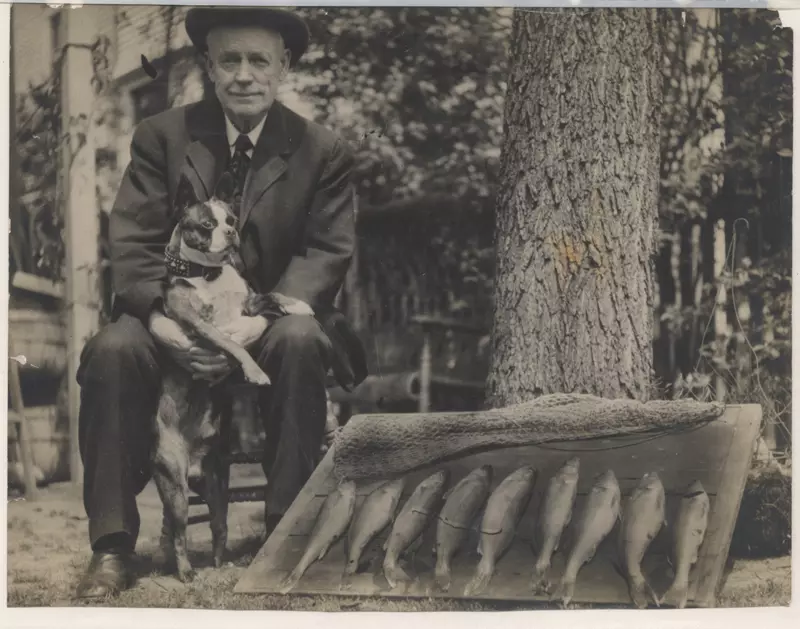 Gunckel in his later years at his cottage on Crystal Lake in Michigan.
Gunckel in his later years at his cottage on Crystal Lake in Michigan.
Through Gunckel’s help, these newsboys grew up to become successful businessmen, doctors, lawyers, judges, teachers, policeman, fireman, public servants, and labor leaders. As adults, they organized a new association to put into practice the principles Gunckel had taught them in their youth.
From those humble beginnings in 1929, the Old Newsboys Goodfellow Association has developed into a major local charity organization that has raised more than $7,000,000 in aid. The group raises the majority of its contributions during its one-day paper sale in early December. The money generated from the sale is used to continue their mission of providing coats and shoes to children throughout the Northwest Ohio area, and helping families that are in need through the watchful eyes of teachers, principals, police officers, and fire officials who request relief on behalf of the children. Since 1972, the Newsboys have also funded several college scholarships each year to area high school seniors who would not otherwise have the chance to attend college. Nearly 1,000 needy families receive emergency food baskets each year thanks to the Old Newsboys.
Today, the Boys and Girls Clubs of Toledo and the Old Newsboys Goodfellow Association continue to carry on the work that John Gunckel began in 1892. Each August, representatives from both groups and children from the Boys and Girls Clubs gather at the Gunckel monument in Woodlawn Cemetery to pay their respects. The copper plate embedded in the monument embodies the debt of gratitude the city of Toledo owes to John Gunckel to this day:
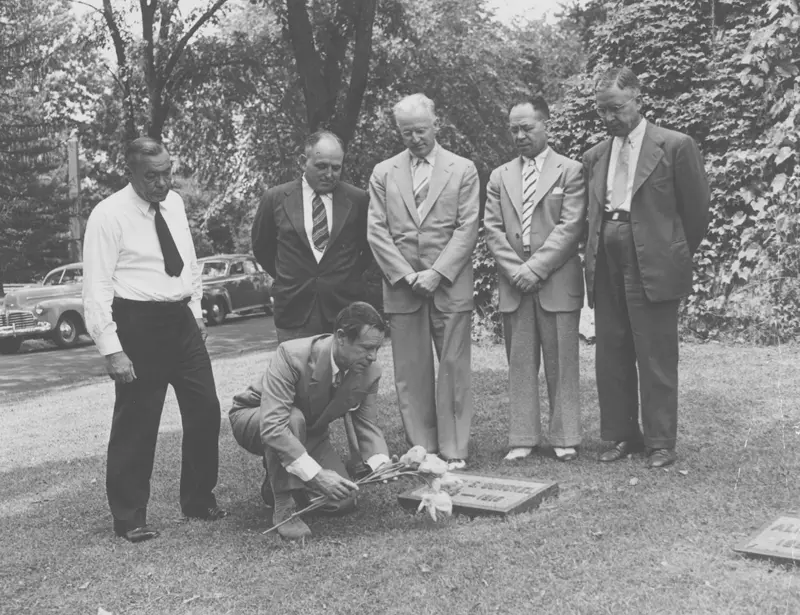 Joe E. Brown pays his respects at the Gunckel Memorial
Joe E. Brown pays his respects at the Gunckel Memorial
THE NEWSBOYS FRIEND JOHN ELSTNER GUNCKEL
1846 – 1915
“There was a man sent from God whose name was John.”
TOLEDO HONORS
A Citizen without reproach
A Friend without pretense
A Philanthropist without display
A Christian without hypocrisy
Major Bibliographical References
Primary Sources
Bibliography files and Scrapbooks. Local History and Genealogy. Toledo Lucas County Public Library.
Manuscripts, pamphlets, documents, etc. found at Woodlawn Cemetery. Woodlawn Cemetery Association 1876-1996. Most of the material is now at the Ward M. Canaday Center, University of Toledo.
In Memory of John E. Gunckel: Founder and Life President of the National and Toledo Newsboys Association, Trustees of Toledo Newsboys Association, Toledo, Ohio, 1915.
The Boys Club of Toledo and the Toledo Newsboys Association, Information Pamphlet, Toledo, Ohio, 1953.
Selling the Gospel News, or: The Strange Career of Jimmy Brown the Newsboy, David E. Whisnant (Journal of Social History, Vol. 5, No. 3, Spring 1972), pp. 269-309
Secondary Sources
Boyville, A History of Fifteen Years' Work Among Newsboys, John E. Gunckel, (Toledo: Toledo Newsboys' Association, 1905).
Toledo’s Attic, www.toledosattic.org, A co-operative project of the Ward M. Canaday Center of the University of Toledo, WGTE Public Broadcasting, the Maumee Valley Historical Society, and the Toledo Lucas County Public Library.
The Story of the Maumee Valley, Toledo and the Sandusky Region, Charles S. Van Tassel, ed. (Chicago: The S.J. Clarke Publishing Co., 1929), 269-270.
Child Labor, Hugh D. Hindman, (New York: M. E. Sharpe, Inc.)
Kids on Strike!, Susan Campbell Bartoletti (New York: Houghton Mifflin Company)
About the Author:
Tedd A. Long is a freelance writer and recreational historian from Sylvania, Ohio. Born and raised in Mansfield, Ohio, Long received a BLS from Bowling Green State University and an Executive Certificate in Strategy and Innovation from the Sloan School of Business at MIT. As a proud lifetime member and past Vice President of the Board of Governors of Toledo’s Old Newsboys Goodfellow Association, Long recently wrote and produced an hour-long documentary on the history of the charity for WGTE TV-30, a Toledo-based public television station.
